Microstructure and Corrosion Resistance of Ti6Al4V Manufactured by Laser Powder Bed Fusion
Abstract
1. Introduction
2. Materials and Methods
2.1. Fabrication of Ti6Al4V by LPBF
2.2. Material Characterization
2.3. Electrochemical Tests
3. Results and Discussion
3.1. Influence of Laser Power and Scanning Rate on the Density and Microstructure of Ti6Al4V Alloy
3.2. Influence of Laser Power and Scanning Rate on the Mechanical Properties of Ti6Al4V Alloy
3.3. Influence of Laser Power and Scanning Rate on the Corrosion Resistance of Ti6Al4V Alloy
4. Conclusions
- (1)
- The microstructure of the Ti6Al4V alloy is composed of α′ martensite and the β phase. Increasing the scanning rate and decreasing the laser power decreases the transformation power from the β phase to the α′ phase and changes the morphology of the α′ phase from lath shaped to acicular. The hardness of the Ti6Al4V alloy reaches the maximum (480.53 HV) for a scanning rate of 1000 mm/s and a laser power of 280 W, owing to the sufficient precipitation of the α′ phase.
- (2)
- Unfused holes occur in the titanium alloy when the laser energy density is too low to melt the power. Pores occur when the laser energy density is too high to vaporize the powder. Both defects reduce the compressive strength of the alloy. The maximum relative density of the Ti6Al4V alloy is 99.96% for a scanning rate of 1200 mm/s and laser power of 240 W, and the compressive strength reached the maximum (1964 MPa).
- (3)
- The influence of the laser power and scanning rate on the corrosion resistance of the Ti6Al4V alloy in the process of the LPBF preparation is a dynamic adjustment process. The corrosion resistance of an alloy can be improved effectively by increasing the scanning rate and laser power in a certain range. However, when the laser energy density is not high enough, simply increasing the scanning rate cannot reduce the grain size and enhance the corrosion resistance of the alloy. The laser power is the primary parameter to be considered. The Ti6Al4V alloy showed the best corrosion resistance when the scanning rate is 1200 mm/s and the laser power is 240 W.
Author Contributions
Funding
Data Availability Statement
Acknowledgments
Conflicts of Interest
References
- Gao, Y.K. Influence of different surface modification treatments on surface integrity and fatigue performance of Ti6Al4V titanium alloy. Acta Metall. Sin. 2016, 52, 915. [Google Scholar]
- Ji, S.D.; Wen, Q.; Ma, L. Microstructure along thickness direction of friction stir welded Ti6Al4V titanium alloy joint. Acta Metall. Sin. 2015, 51, 1391. [Google Scholar]
- Lu, S.L.; Qian, M.; Tang, H.P.; Yan, M.; Wang, J.; St John, D.H. Massive transformation in Ti-6Al-4V additively manufactured by selective electron beam melting. Acta Mater. 2016, 104, 303. [Google Scholar] [CrossRef]
- Tan, X.P.; Kok, Y.; Tan, Y.J.; Descoins, M.; Mangelinck, D.; Tor, S.B.; Leong, K.F.; Chua, C.K. Graded microstructure and mechanical properties of additive manufactured Ti-6Al-4V via electron beam melting. Acta Mater. 2015, 97, 1. [Google Scholar] [CrossRef]
- Mozaffar, M.; Ndip-Agbor, E.; Lin, S.; Wagner, G.J.; Ehmann, K.; Cao, J. Acceleration strategies for explicit finite element analysis of metal powder-based additive manufacturing processes using graphical processing units. Comput. Mech. 2019, 64, 879. [Google Scholar] [CrossRef]
- Deng, H.; Chen, Y.; Jia, Y.; Pang, Y.; Zhang, T.; Wang, S.; Yin, L. Microstructure and mechanical properties of dissimilar NiTi/Ti6Al4V joints via back-heating assisted friction stir welding. J. Manuf. Process. 2021, 64, 379. [Google Scholar] [CrossRef]
- Suo, H.B.; Chen, Z.Y.; Liu, J.R.; Gong, S.; Xiao, J. Microstructure and mechanical properties of Ti-6Al-4V by electron beam rapid manufacturing. Rare Met. Mater. Eng. 2014, 43, 780. [Google Scholar] [CrossRef]
- Thijs, L.; Verhaeghe, F.; Craeghs, T.; Van Humbeeck, J.; Kruth, J.-P. A study of the microstructural evolution during selective laser melting of Ti-6Al-4V. Acta Mater. 2010, 58, 3303. [Google Scholar] [CrossRef]
- Liu, Z.; Zhao, Z.B.; Liu, J.R.; Wang, L.; Yang, G.; Gong, S.; Wang, Q.; Yang, R. Microstructure and mechanical properties of Ti-6Al-4V alloy produced by electron beam fabrication. Mater. Sci. Eng. A 2019, 742, 508. [Google Scholar] [CrossRef]
- Yang, Y.; Gong, Y.; Li, C.; Wen, X.; Sun, J. Mechanical performance of 316 L stainless steel by hybrid directed energy deposition and thermal milling process. J. Mater. Process. Technol. 2021, 291, 117023. [Google Scholar] [CrossRef]
- Abedi, H.R.; Hanzaki, A.Z.; Azami, M.; Kahnooji, M.; Rahmatabadi, D. The high temperature flow behavior of additively manufactured Inconel 625 superalloy. Mater. Res. Express 2019, 6, 116514. [Google Scholar] [CrossRef]
- Shang, J.Y.; Zhan, P.; Jiang, C.; Zou, Y.; Liu, H.; Zhang, B.; Dai, M. Inhibitory effects of lanthanum chloride on wear particle-induced osteolysis in a mouse calvarial model. Biol. Trace. Elem. Res. 2016, 169, 303. [Google Scholar] [CrossRef]
- Lu, Y.; Yang, C.; Liu, Y.; Yang, K.; Lin, J. Characterization of lattice defects and tensile deformation of biomedical Co29Cr9W3Cu alloy produced by selective laser melting. Addit. Manuf. 2019, 30, 100908. [Google Scholar] [CrossRef]
- Hooreweder, B.V.; Apers, Y.; Lietaert, K.; Kruth, J.-P. Improving the fatigue performance of porous metallic biomaterials produced by Selective Laser Melting. Acta Biomater. 2017, 47, 193. [Google Scholar] [CrossRef]
- Nie, X.J.; Zhang, H.; Zhu, H.H.; Hu, Z.; Ke, L.; Zeng, X. Analysis of processing parameters and characteristics of selective laser melted high strength Al-Cu-Mg alloys: From single tracks to cubic samples. J. Mater. Process. Technol. 2018, 256, 69. [Google Scholar] [CrossRef]
- Liu, Y.; Yang, Y.Q.; Wang, D. A study on the residual stress during selective laser melting (SLM) of metallic powder. Int. J. Adv. Manuf. Technol. 2016, 87, 647. [Google Scholar] [CrossRef]
- Edwards, P.; Ramulu, M. Fatigue Performance Evaluation of Selective Laser Melted Ti6Al4V. Mater. Sci.Eng. A 2014, 598, 327. [Google Scholar] [CrossRef]
- Dai, N.; Zhang, L.-C.; Zhang, J.; Chen, Q.; Wu, M. Corrosion behavior of selective laser melted Ti-6Al-4 V alloy in NaCl solution. Corros. Sci. 2016, 102, 484. [Google Scholar] [CrossRef]
- Vandenbroucke, B.; Kruth, J.P. Selective laser melting of biocompatible metals for rapid manufacturing of medical parts. Rapid Prototyp. J. 2007, 13, 196. [Google Scholar] [CrossRef]
- Song, B.; Dong, S.; Zhang, B.; Liao, H.; Coddet, C. Effects of processing parameters on microstructure and mechanical property of selective laser melted Ti6Al4V. Mater. Des. 2012, 35, 120. [Google Scholar] [CrossRef]
- Li, J.; Lin, X.; Qian, Y.H.; Huang, W. Study on Microstructure and Property of Laser Solid Forming Ti6Al4V Titanium Alloy. Chin. J. Lasers 2014, 41, 103. [Google Scholar]
- Ren, Y.; Wu, H.; Du, J.; Liu, B.; Wang, X.; Jiao, Z.; Tian, Y.; Baker, I. Effect of laser scanning speed on microstructure, tribological and corrosion behavior of Ti-23Nb alloys produced by laser metal deposition. Mater. Charact. 2023, 197, 112647. [Google Scholar] [CrossRef]
- Kürnsteiner, P.; Wilms, M.B.; Weisheit, A.; Gault, B.; Jägle, E.A.; Raabe, D. High-strength Damascus steel by additive manufacturing. Nature 2020, 582, 515. [Google Scholar] [CrossRef]
- Jiang, P.; Zhang, C.; Zhang, S.; Zhang, J.; Chen, J.; Chen, H. Additive manufacturing of novel ferritic stainless steel by selective laser melting: Role of laser scanning speed on the formability, microstructure and properties. Opt. Laser Technol. 2021, 140, 107055. [Google Scholar] [CrossRef]
- Wei, K.W.; Wang, Z.M.; Zeng, X.Y. Element loss of AZ91D magnesium alloy during selective laser melting process. Acta Metall. Sin. 2016, 52, 184. [Google Scholar]
- Gao, P.; Wei, K.W.; Yu, H.C.; Yang, J.; Wang, Z.; Zeng, X. Effect of layer thickness on microstructure and properties of Ti-5Al-2.5Sn alloy formed by selective laser melting. Acta Metall. Sin. 2018, 54, 999. [Google Scholar]
- Alphons, A.A. Microstructure, Texture and Mechanical Property Evolution during Additive Manufacturing of Ti6Al4V Alloy for Aerospace Applications; The University of Manchester: Manchester, UK, 2012; Volume 61. [Google Scholar]
- Ahmed, T.; Rack, H.J. Phase transformations during cooling in α + β titanium alloys. Mater. Sci. Eng. 1998, A243, 206. [Google Scholar] [CrossRef]
- Gong, H.J.; Rafi, K.; Gu, H.F.; Ram, G.D.J.; Starr, T.; Stucker, B. Influence of defects on mechanical properties of Ti-6Al-4 V components produced by selective laser melting and electron beam melting. Mater. Des. 2015, 86, 545. [Google Scholar] [CrossRef]
- Roehling, J.D.; Smith, W.L.; Roehling, T.T.; Vrancken, B.; Guss, G.M.; McKeown, J.T.; Hill, M.R.; Matthews, M.J. Reducing residual stress by selective large-area diode surface heating during laser powder bed fusion additive manufacturing. Addit. Manuf. 2019, 28, 228. [Google Scholar] [CrossRef]
- Zhao, M.Q.; Lei, A.L. Corrosion and Protection of Metals; National Defense Industry Press: Beijing, China, 2002; Volume 9. [Google Scholar]
- Huang, R.; Han, Y. The effect of SMAT-induced grain refinement and dislocations on the corrosion behavior of Ti–25Nb–3Mo–3Zr–2Sn alloy. Mater. Sci. Eng. C 2013, 33, 2353. [Google Scholar] [CrossRef]
- Ralston, K.; Birbilis, N.; Davies, C. Revealing the relationship between grain size and corrosion rate of metals. Scr. Mater. 2010, 63, 1201. [Google Scholar] [CrossRef]
- Wu, Y.C.; Kuo, C.N.; Chung, Y.C.; Ng, C.H.; Huang, J.C. Effects of Electropolishing on Mechanical Properties and Bio-Corrosion of Ti6Al4V Fabricated by Electron Beam Melting Additive Manufacturing. Materials 2019, 12, 1466. [Google Scholar] [CrossRef] [PubMed]
- Gong, Y.; Wu, M.; Miao, X.; Cui, C. Effect of laser power on corrosion behavior of GO/Ti-6Al-4V coating in simulated body fluid solution. J. Laser Appl. 2022, 34, 22004. [Google Scholar] [CrossRef]
- Avinash, D.; Leo Kumar, S.P. Investigations on corrosion resistance behavior in micro-milling of Ti-6Al-4V and Ti-6Al-7Nb alloy: A comparative study. J. Mech. Sci. Technol. 2020, 34, 1. [Google Scholar] [CrossRef]
- Hu, J.; Ren, Y.; Huang, Q.; He, H.; Liang, L.; Liu, J.; Li, R.; Wu, H. Microstructure and Corrosion Behavior of Ti-Nb Coatings on NiTi Substrate Fabricated by Laser Cladding. Coatings 2021, 11, 597. [Google Scholar] [CrossRef]
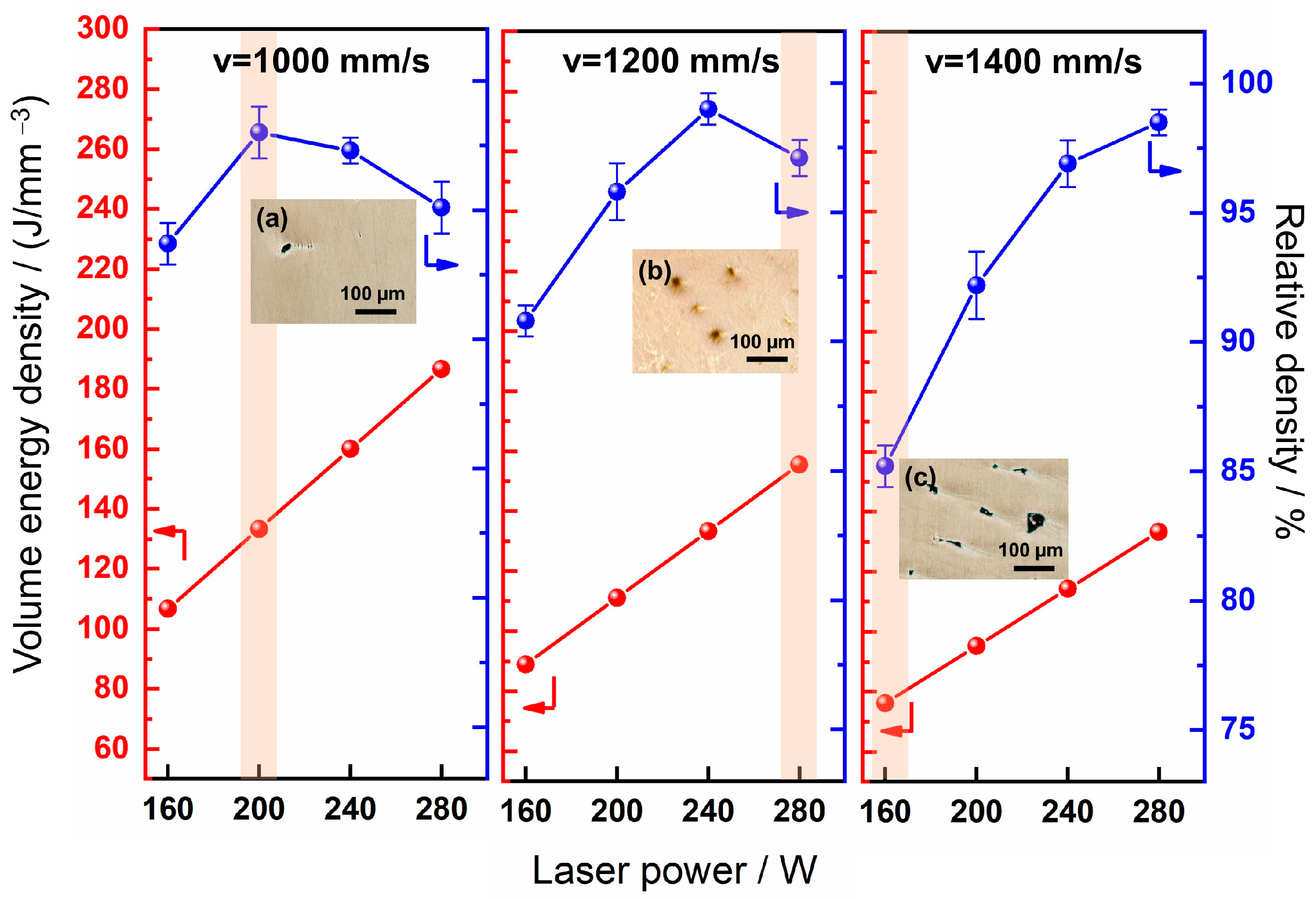
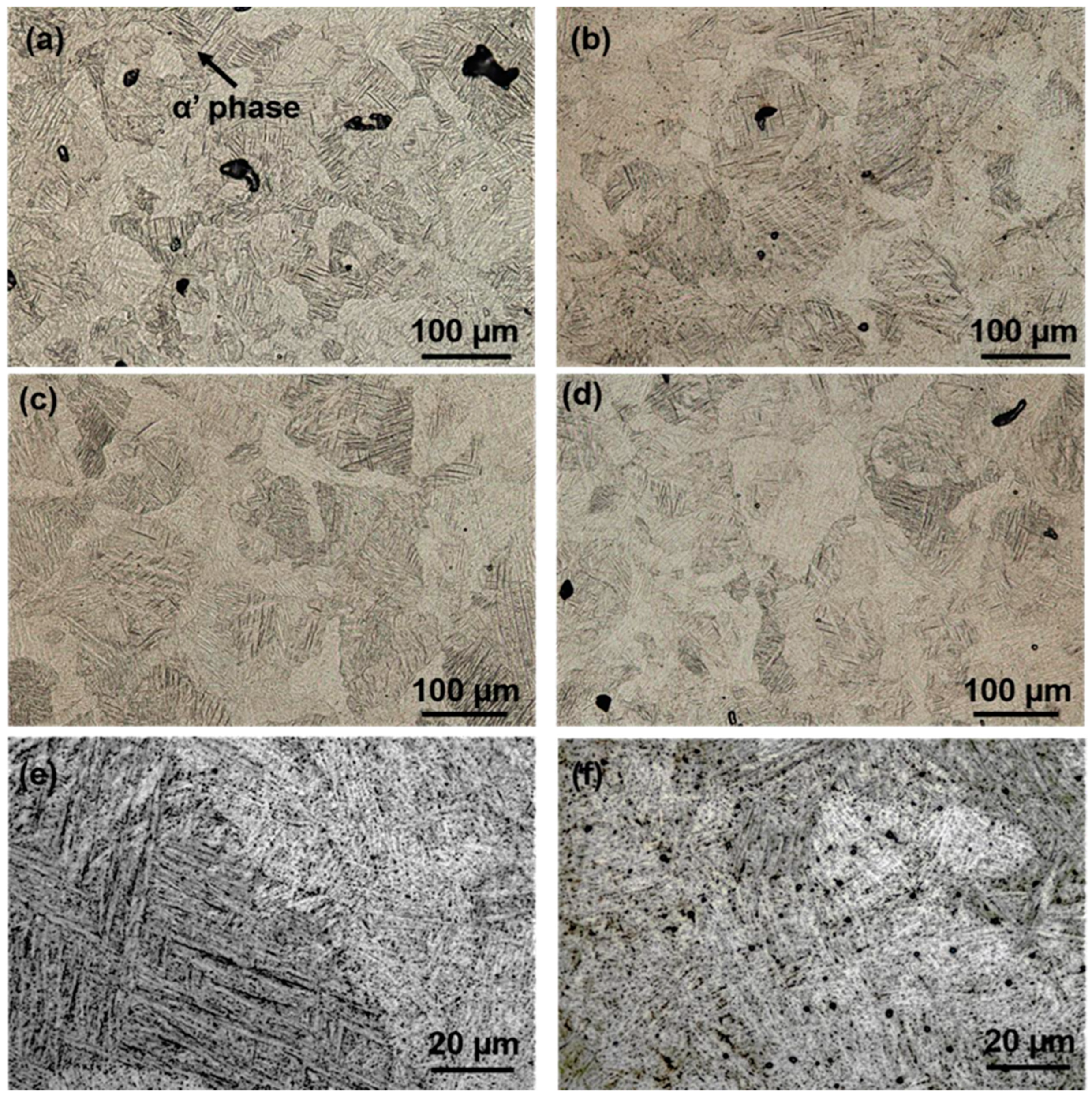

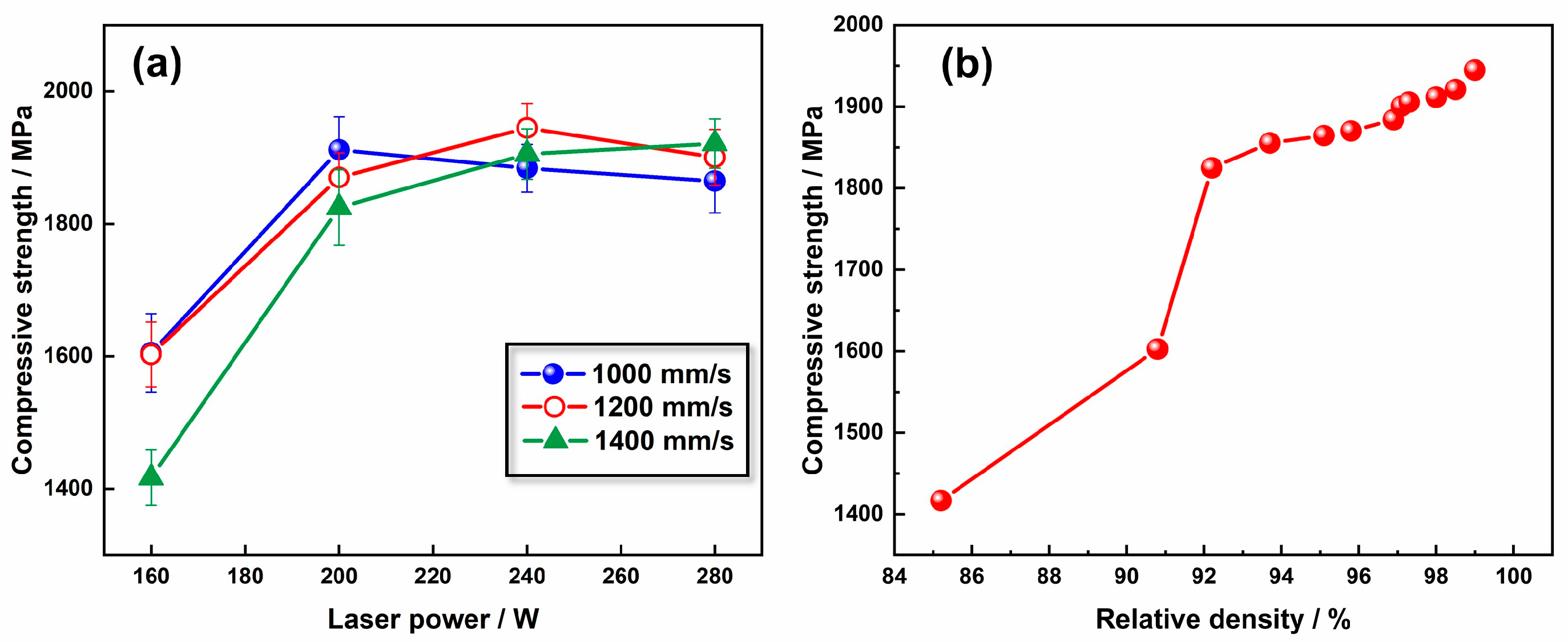
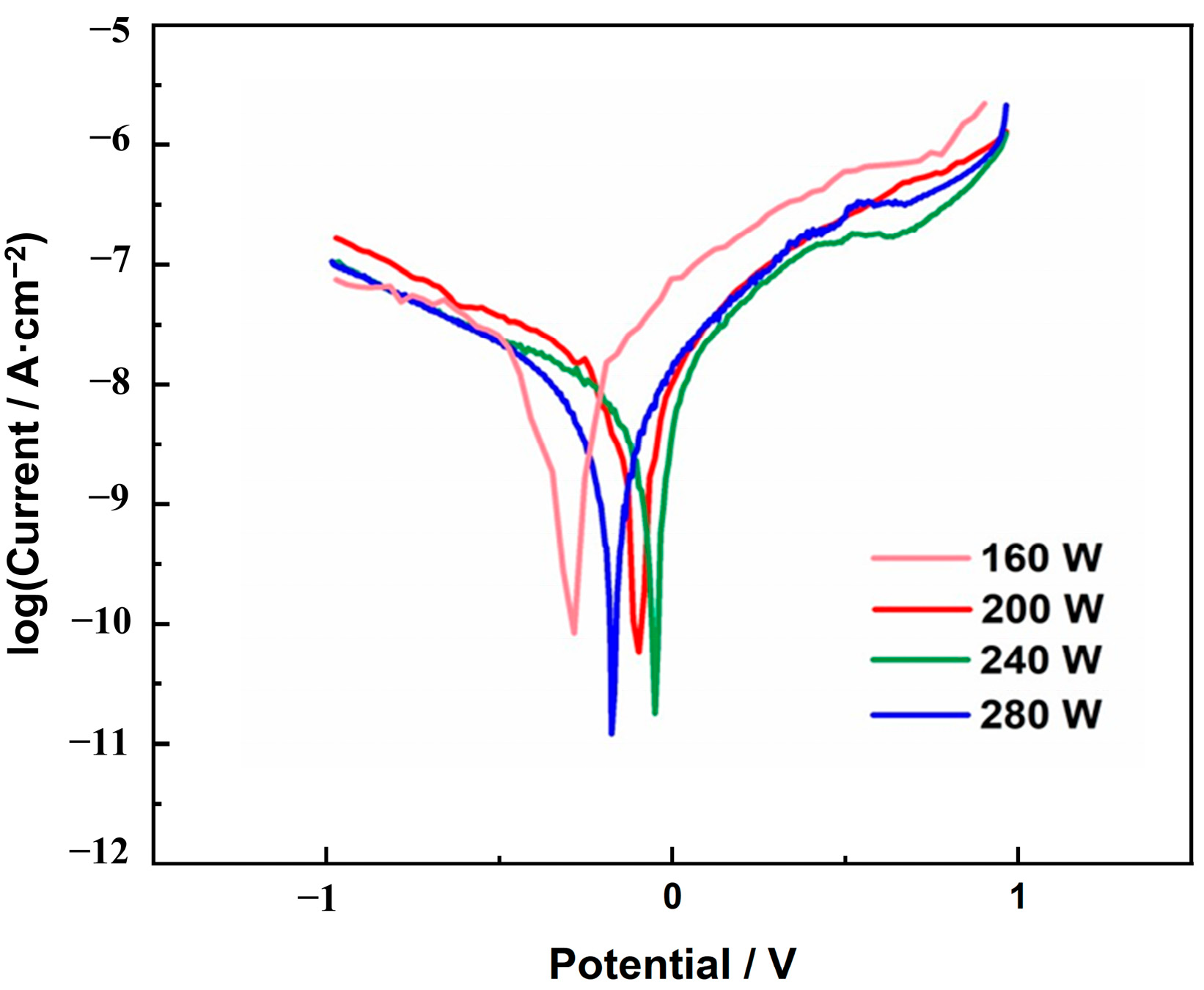
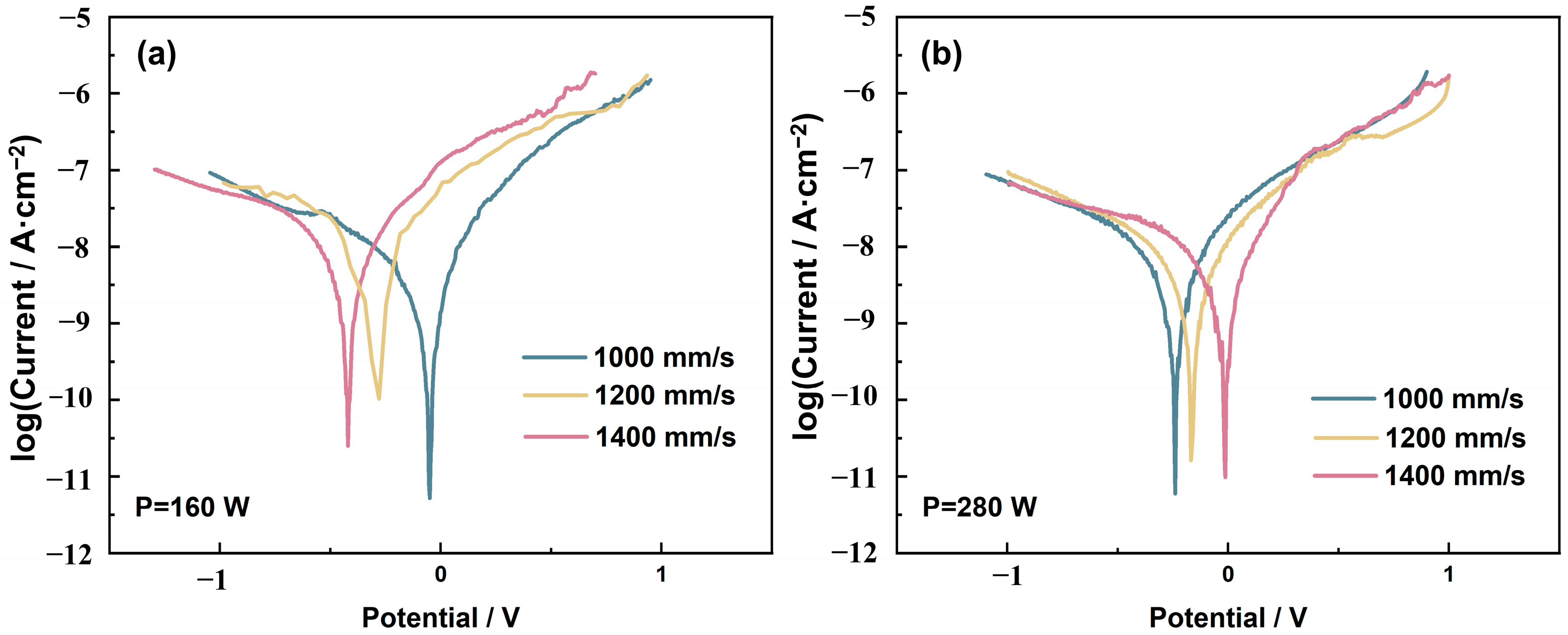
| Laser Power/W | Ecorr/V | Icorr/(nA·cm−2) | Rp (MΩ·cm2) |
|---|---|---|---|
| 160 | −0.28 | 25.37 | 1.25 |
| 200 | −0.09 | 12.21 | 2.73 |
| 240 | −0.04 | 7.94 | 3.16 |
| 280 | −0.17 | 9.88 | 2.41 |
| Scanning Rate/(mm/s) | 160 W | 280 W | ||||
|---|---|---|---|---|---|---|
| Ecorr/V | Icorr/(nA·cm−2) | Rp (MΩ·cm2) | Ecorr/V | Icorr/(nA·cm−2) | Rp/(MΩ·cm2) | |
| 1000 | −0.06 | 15.89 | 2.57 | −0.25 | 9.30 | 1.98 |
| 1200 | −0.28 | 25.37 | 1.25 | −0.17 | 9.88 | 2.41 |
| 1400 | −0.41 | 28.76 | 0.87 | −0.04 | 9.74 | 2.94 |
| Alloys | Ecorr/V | Icorr/(nA·cm−2) | Reference |
|---|---|---|---|
| Ti6Al4V | −0.04 | 7.94 | this work |
| Ti6Al4V | −0.369 ± 0.008 | 15.47 ± 4.40 | [34] |
| Ti6Al4V | - | 73.8 | [35] |
| Ti6Al4V | −0.144 | 41 | [36] |
| NiTi | −0.220 ± 0.004 | 410.9 ± 67.7 | [37] |
| Ti-23Nb | - | 13.2 | [22] |
Disclaimer/Publisher’s Note: The statements, opinions and data contained in all publications are solely those of the individual author(s) and contributor(s) and not of MDPI and/or the editor(s). MDPI and/or the editor(s) disclaim responsibility for any injury to people or property resulting from any ideas, methods, instructions or products referred to in the content. |
© 2023 by the authors. Licensee MDPI, Basel, Switzerland. This article is an open access article distributed under the terms and conditions of the Creative Commons Attribution (CC BY) license (https://creativecommons.org/licenses/by/4.0/).
Share and Cite
Luo, Y.; Wang, M.; Zhu, J.; Tu, J.; Jiao, S. Microstructure and Corrosion Resistance of Ti6Al4V Manufactured by Laser Powder Bed Fusion. Metals 2023, 13, 496. https://doi.org/10.3390/met13030496
Luo Y, Wang M, Zhu J, Tu J, Jiao S. Microstructure and Corrosion Resistance of Ti6Al4V Manufactured by Laser Powder Bed Fusion. Metals. 2023; 13(3):496. https://doi.org/10.3390/met13030496
Chicago/Turabian StyleLuo, Yiwa, Mingyong Wang, Jun Zhu, Jiguo Tu, and Shuqiang Jiao. 2023. "Microstructure and Corrosion Resistance of Ti6Al4V Manufactured by Laser Powder Bed Fusion" Metals 13, no. 3: 496. https://doi.org/10.3390/met13030496
APA StyleLuo, Y., Wang, M., Zhu, J., Tu, J., & Jiao, S. (2023). Microstructure and Corrosion Resistance of Ti6Al4V Manufactured by Laser Powder Bed Fusion. Metals, 13(3), 496. https://doi.org/10.3390/met13030496









